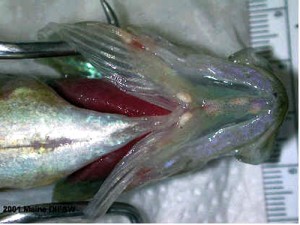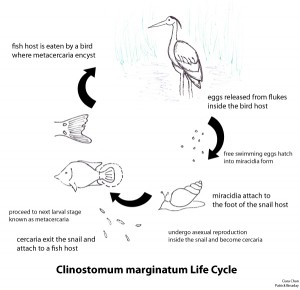By Chris Erwin
Finding a worm or grub in fish is not a new thing here in the local area. These little parasites pop up now and then. However, in recent weeks I have had a number of reports of local fisherman finding these little white or yellow worms and grubs in the meat of the fish that they cleaned to eat.
I felt I should do a little research and pass along what I could find out about these little critters, what you should know about them, and what you should do in the event you find them in the fish you catch.
I contacted Fred Howes, district biologist of the Kentucky Department of Fish and Wildlife to ask him some of the questions I thought you would like to see answered. Below are my questions and Howe’s answers.

“These are good questions of which a bunch of anglers undoubtedly also have questions about,” Howes responded to my inquiry. “These critters have a somewhat complex life cycle and I will hopefully make it understandable.”
Q: What are these grubs and where do they come from?
A: First of all, without seeing the organism one cannot make a positive ID as to what species it is. For general purposes what is in these fish are a type of trematode, which are parasites. (Black, Yellow or White Grub). There are two types of trematodes: Monogenetic, which completes its life cycle on a fish without involving another host, and digenetic, which completes its life cycle involving one or more hosts, usually snails and fish eating birds. Most probably, we’re talking about digenetic trematodes at Greenbo, and really these are found all over the place as they are common throughout North America. It is the larval stage of this grub, which infects fish. 
How it works: The adult parasite is found in the throat of fish eating birds, primarily Herons. Eggs are then washed out of the mouth, or I’ve also heard, from the feces of the bird and enter the water. Eggs then hatch out in the water in the form of a free-swimming larval stage, where they are called miracidia. The larval stage attaches itself to snails in the water, and more development occurs including asexual reproduction. They emerge from the snail in another free-swimming stage, and are knon as cercaria. They then seek out fish and attach where they develop into the spots anglers see on fish. The grubs most probably penetrate the flesh at this stage where metacercaria encyst. Once a bird eats an infected fish the whole process begins again.
Q: Is the meat of an infected fish still useable or is it harmful?
A: In most cases, as long as the fish is cooked properly, it’s O.K. to eat. However, most anglers who see the worms don’t eat them for good reasons.
Q: Does this happen in a certain time of the season or does it happen year round?
A: The grubs, or one form of their life cycle is always present. It seems like most of the complaints we receive are during the summer months when the grubs are in the metacercaria stage.
Q: Is this something that FWL treats for, or does it naturally cure itself?
A: We do not, nor can we treat this parasite. In order to attempt to get rid of it, you have to eliminate one of the hosts. For small ponds, there are some things a person can do, but for a major body of water, there’s not much one can do. Over my tenure in fisheries, I have seen ponds wax and wane in terms of the magnitude of infestation. I do not know why this happens, perhaps environmental conditions, or a reduction in fish eating bird occurs. I don’t know.
Q: What precautions should be passed along to the public?
A: Always properly cook your fish! I personally would pitch a fish if it was full of worms.



Good day
I have herd if you soak the filets, ( edible part of the fish ) in a bowl of salt water it will kill the grub and some will come out on there own and be dead in the bowl. ? Is this true?
John, that sounds like a true statement;however, if the filets have more than what I can see to remove I don’t eat them. If I catch more that one fish (crappie) since this is the olny fish I normaly eat,that has worms I usually move to a different lacation. Since this infestation is usually isolated to a place where these birds are using by moving to a different lacation you usually don’t continue to see them.
Chris Erwin